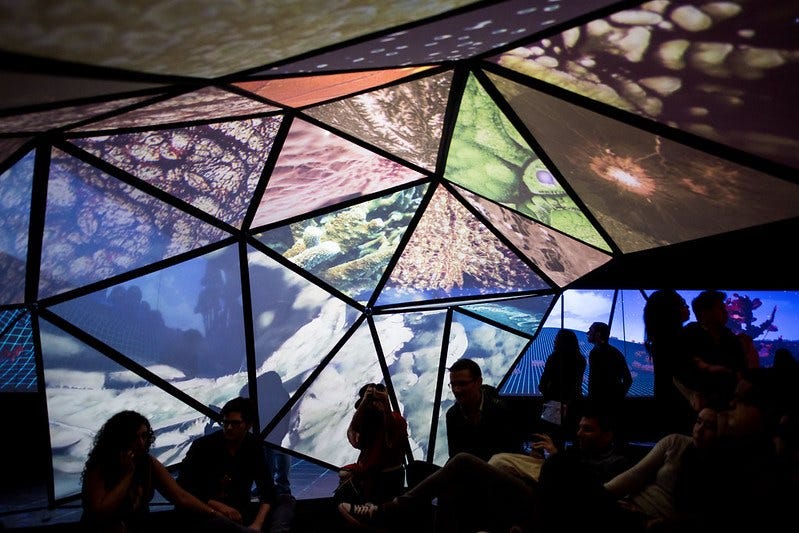
“This will be the end of you. The end of you and the beginning of us.”
So says the show’s leaflet, which serves as a map and oracle. In the lobby of the historic Grand Theater in San Francisco’s Mission District, I stand in front of “The RegisTree,” a tree-like structure emerging from the wall, covered in barnacled bark with wires protruding like exposed veins from amputated branches. From an implanted screen, I am invited to create a new identity by selecting a “collective” to merge with: microscopic images of organic matter such as bees, water, and leaves. From one of the tree’s knots, a camera takes my photo and prints my newly intertwined identity. “The RegisTree” coughs up a keycard. My portrait resembles the latticed, angular pointillism of a Chuck Close filter. The keycard is made of plastic.
Gray Area’s The End of You presents a series of immersive installations centered around humans’ fraught, delicate, and intimate relationship with the natural world. Conceptually, The End of You’s installations are compelling and beautifully crafted. They are birthed from our modern existential crises of the natural world: what will we physically leave behind? Can we reframe meaning in our lives outside of consumerism? How is nature embedded in our sense of self as we burrow deeper into digitally-dominated spaces? Who shoulders the burden of pollution, negligence, and abuse of the natural world?

I walk into the main room. It is a sensory field: projected images on the walls and floor, two suspended tree trunks, a geodesic dome with illuminated panels, open shelves stocked with objects of daily life, each one identified and tagged. Free to move around the space, I approach “The Luxuriant Prolific Undying.” Roots from red alder and cedar trees grip the air in front of me. I stand on a white bank of gravel and listen through headphones to a guided meditation while tracking the colorful abstraction of “The Uncanny Forest,” a digital projection of seasonal growth and decay. Around me, pomegranates (or perhaps apples) hang from fishing lines. I concentrate on the somewhat robotic voice: an alien being? A human (not too) far into the future? It’s unclear who is talking me through this journey, but I do laugh at the phrase “thoughts do not exist without bacteria.”
“Terminal Blurring” challenges our perception of scale and pattern. Under the geodesic dome’s canopy, each panel oscillates between images from the natural world, from the micro to the macro; most identifying details are rendered unattributable and the pulsating quality of the imagery is unsettling. “An Immersive Game of Life” encompasses the rear of the theater. In this game, a projected grid on the floor sprouts mushrooms and other plants as I move between each grid square; the screens surrounding me flicker with a desert-like landscape, but the interactive effects produce muted results.
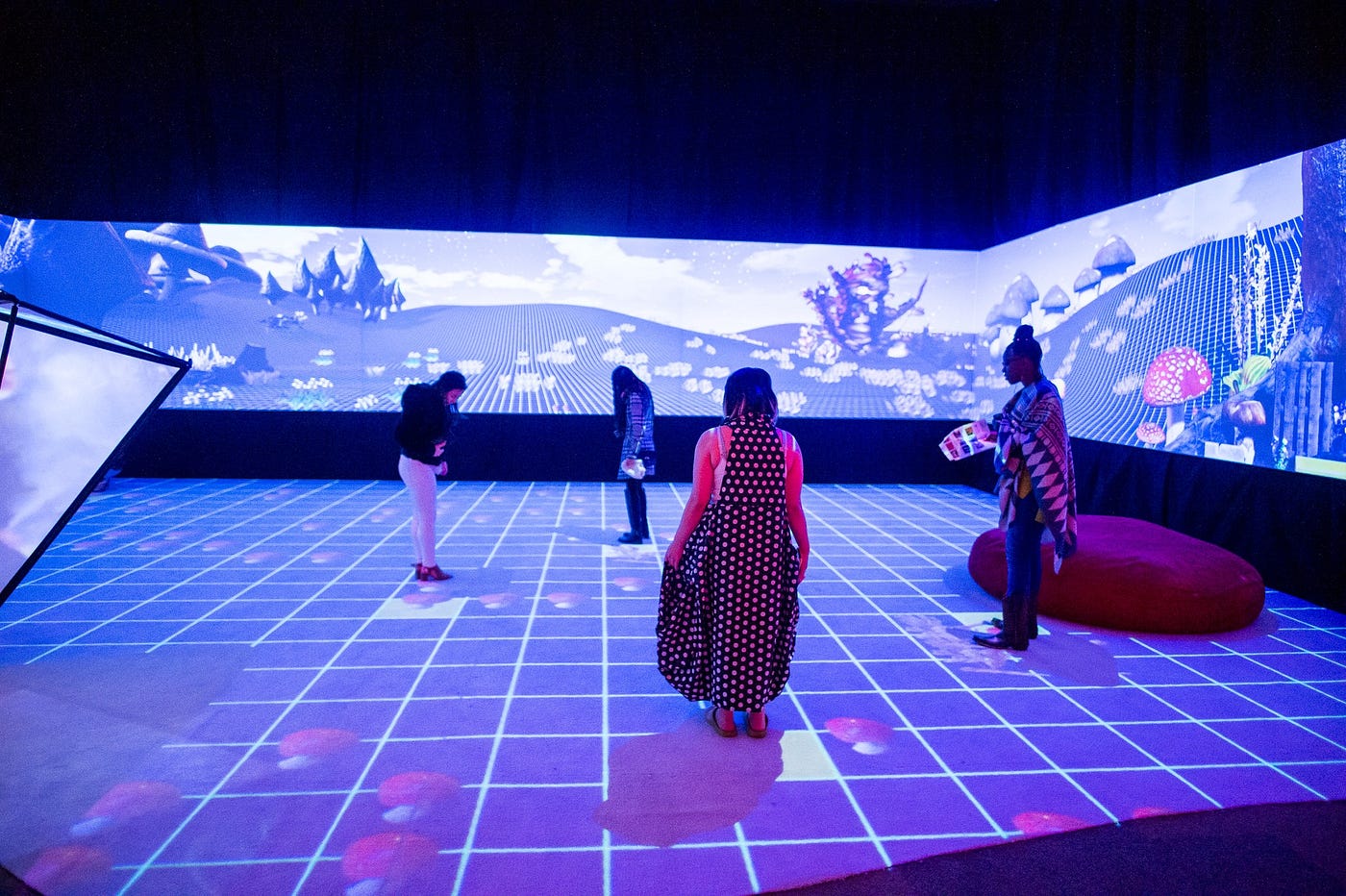
In the center of the room, the paper lanterns of “THIS HAMMER” flash with staccato rhythm. A kinetic memorial to the ongoing radioactive cleanup crisis in San Francisco’s Hunters Point, “THIS HAMMER” demands attention to chronic, toxic waste dump in marginalized communities. As viewers approach the sculpture, the intensity of the irradiating lanterns is meant to increase, but any significant change from my movement was unnoticeable. And bathed in the saturated red of a darkroom, “The Archive of Human Nature” strips objects of their true color and context. This cross-section of humanity includes a laptop, makeup primer, food cooler, Slack-branded drinking glass, license plate, birdhouse, and Bernie Sanders campaign sign. More morgue than antique shop, each item is named, numbered, dated, and “submitted by Homo sapiens.” A guide sits off to the side, near “The Archive of Human Nature,” which heightens the bureaucratic formality of the work.
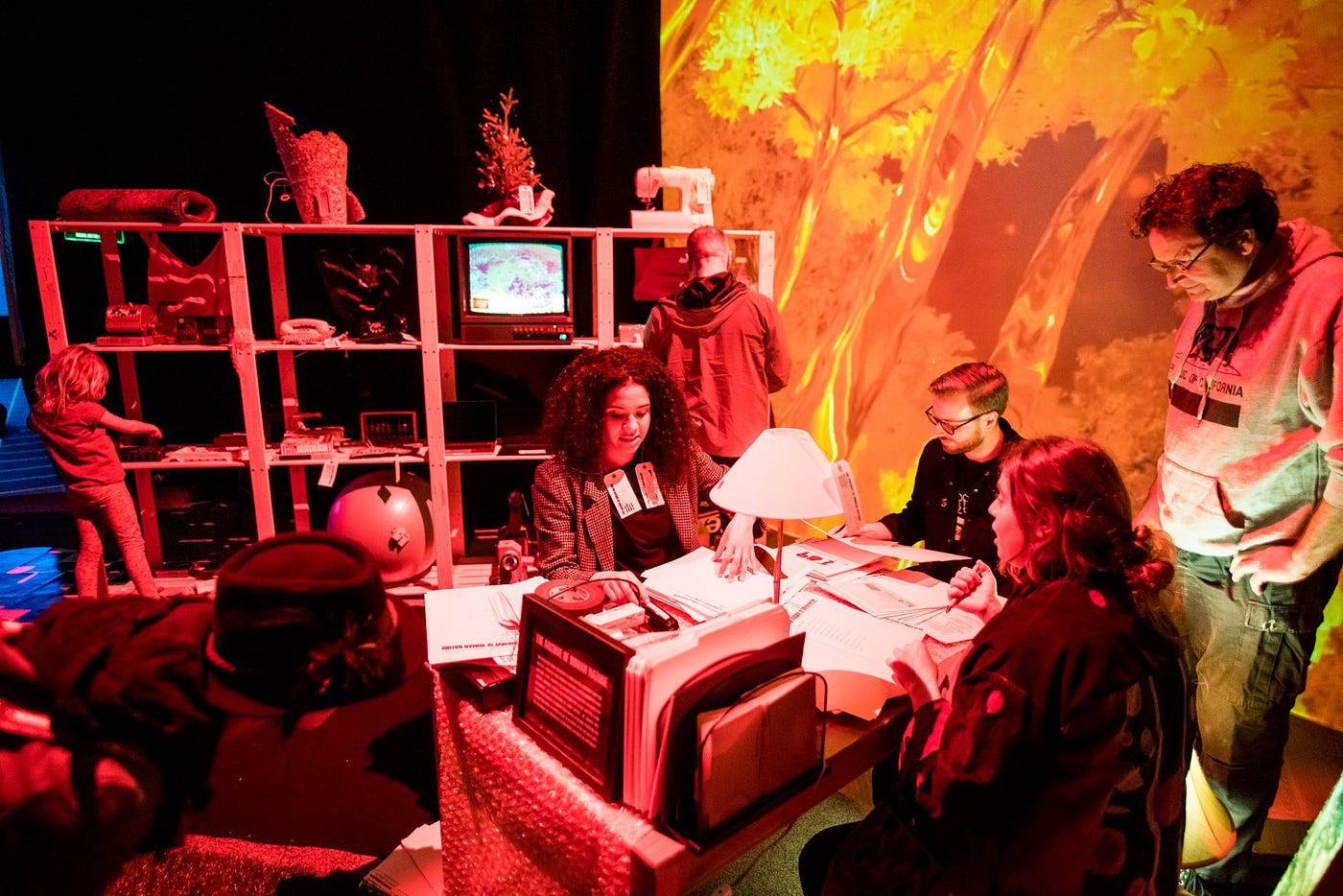
In a small, adjacent space is “The Room of Relations,” which includes video projections, a soundscape, a compact animal portrait gallery, and a table full of press releases about natural features and regions granted “personhood” status. Items in “The Room of Relations” share thematic overtones, but the presentation is disjointed and unpersuasive.
Get Laura Hess’s stories in your inbox
Join Medium for free to get updates from this writer.
SubscribeSubscribe
The climate crisis is truly a vast and omnipresent emergency and The End of You is spatially immersive, but there is a veil between the exploring visitor and the installations; it lacks the inherent power of its subject: awe. Inherent in awe is the tension between reverential wonder and fear. As our planet’s ultimate, sacred, and sublime authority, nature is most demanding of profound respect. In the natural world, we cycle through the singular joy of astonishment and the utter horror of destruction at an unparalleled level. This awe is a merging of “self” and “other.” It’s a suspension of time and thought. We become excruciatingly aware of our senses and environment while obliterating distance between the two.
At The End of You, however, I did not feel a blurred sense of self. I did not feel emotional resonance by way of a buzzy connection with my environment or those around me. I looked at the plastic keycard in my hand and saw a missed opportunity. Why was this not printed on plantable paper, ingrained with seeds? Why not complete this journey with a more genuine fusion of self and the natural world? To carry home a transmission of my physical likeness now imbued with new potential; to bring forth another life form as my image decays, disappears, and is replaced with living matter for me to care for? That, instead, could have been a real beginning of “us.”
Instead, I left with a totem without any heightened purpose. I left feeling unsatisfied and unchanged. The collection of installations sufficiently filled the space and were thematically unified, but the exhibition didn’t succeed as a holistic presentation driving the viewer through a type of transformation. The End of You’s messaging addresses a vital issue of our time, one that affects all people. In the show’s leaflet, it asks, “What are the boundaries of the self? …we often view humanity as separate from nature instead of part of a greater living system. If everything is entangled — from the microbe to the macroeconomy — how can we rethink our relationship with the living world? What might happen when we stop seeing ourselves as individuals acting in isolation to experience the world as nested expressions of a larger whole?”
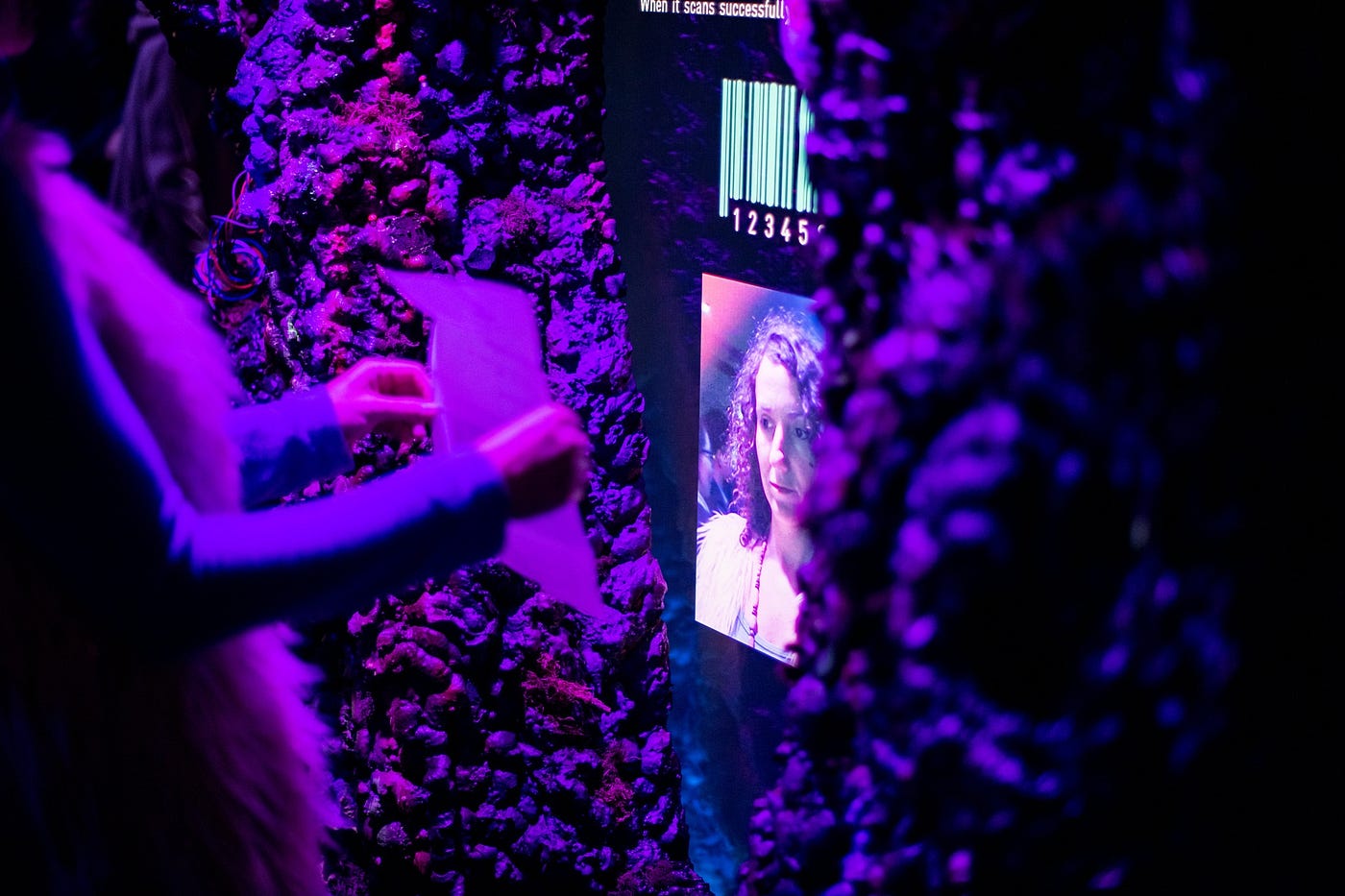
“The RegisTree” was the most successful on this front, which is why it made the deepest impression when it ultimately failed to deliver. Each installation had been carefully conceived, but in actuality, interactivity and impact were limited. Individual installations needed to impart either wonder or dread to create awe as a collective whole. This could have been achieved by greater integration, personalization, focus, or scope, all of which are incredibly demanding and complex elements.
But rather than feeling drawn into the work, it felt as though there was a membrane sealed around the installations, acting as a barrier to visceral connectivity; I couldn’t get an emotional toehold into the exhibit. Still, there were moments of gorgeous imagery. They just didn’t implant inside me and grow something new.
End of You at Gray Area has concluded.
Gray Area is currently collecting funds to stay open in San Francisco.
NoPro is a labor of love made possible by our generous Patreon backers. Join them today!
In addition to the No Proscenium web site, our podcast, and our newsletters, you can find NoPro on Twitter, Facebook, YouTube, Instagram, in the Facebook community Everything Immersive, and on our Slack forum.
Office facilities provided by Thymele Arts, in Los Angeles, CA.


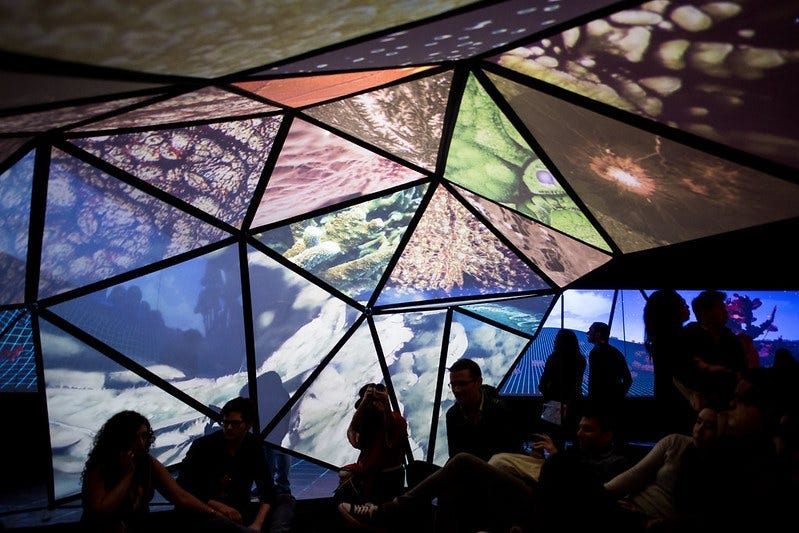

















Discussion